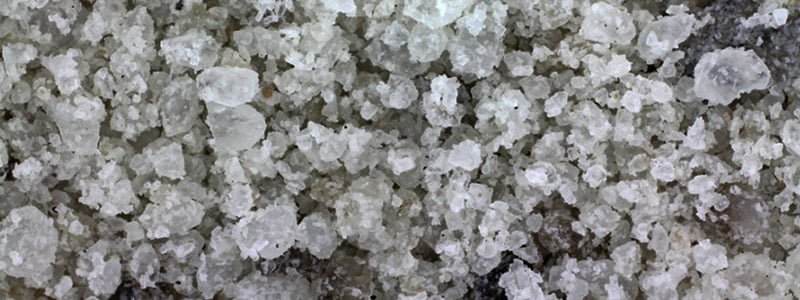Rock salt and deicer agents are commonly used before, during, and after a storm. While salt is an effective deicer tool for driveways, sidewalks, and roads, before emptying several bags of salt onto your paved surfaces, consider a few things.
- What material is your pavement?
- If your pavement is asphalt, we have good news! Salt and deicer will not deteriorate your pavement because of asphalt’s hot-mix technology. This is because hot-mix asphalt is made from stones, sand, and petroleum, making it specifically engineered to withstand the freeze-thaw cycle.
- If your paved surface is concrete, salt and deicer will have a different effect. Salt does in fact cause concrete deterioration. Because of the acid in rock salt and deicing products, salt application does break down the bonds that hold concrete together. Unfortunately, concrete also freezes more quickly than other surfaces, meaning that more rock salt is often required to keep your concrete from being slick. The more salt, the more deterioration.
- Can salt cause breakage or potholes?
 Well, as mentioned above, if your pavement surface is asphalt, salt applications have little deterioration affects. Potholes are actually caused by expanding and contracting of the pavement that occurs because of winter’s fluctuating temperatures. When cracks form, water gets in them. When temperatures fluctuate from freezing to above freezing, this water freezes and melts causing contraction and lifting of pavement. When the ice under the lifted pavement melts, the pavement remains lifted with nothing solid under it. When a car drives over this hallow lifted pavement, it breaks leading to potholes.
Well, as mentioned above, if your pavement surface is asphalt, salt applications have little deterioration affects. Potholes are actually caused by expanding and contracting of the pavement that occurs because of winter’s fluctuating temperatures. When cracks form, water gets in them. When temperatures fluctuate from freezing to above freezing, this water freezes and melts causing contraction and lifting of pavement. When the ice under the lifted pavement melts, the pavement remains lifted with nothing solid under it. When a car drives over this hallow lifted pavement, it breaks leading to potholes.- While salts and deicers do not contribute to creating potholes, they can contribute to making the problem worse by keeping the water in liquid form at lower temperatures. Meaning, that the freeze-thaw cycle can now occur at varying temperatures below freezing, instead of only occurring when temperatures fluctuate from freezing to above freezing.
- Is salting “green”?
- Water runoff from pavement heads directly towards surrounding wooded areas, bodies of water, grass, and plants. The salt, unfortunately can affect these areas, and the animals that live in them. Excessive salting can lead to increased salinity in rivers and drinking water for humans and animals.
- Does sand melt ice?
- When sand is applied to driveways or roads, it is often to help improve tire traction rather than melt ice. While the goal of creating a safer driving experience is the same for both sand and salt applications, sand will not actually melt the ice. When cars drive over sand, the grains of sand move around. This movement makes it difficult for molecules to stick together and form ice. Because of this, sand can be a beneficial tool in helping to prevent future ice formation. So, although sand does not melt ice, and can’t prevent it entirely from forming, it can significantly help with tire traction and decrease slickness.
Your asphalt is a big investment, and because of this, it is important to do you research before applying anything to it. While winter pavement damages and deterioration is inevitable in areas with harsh winters, these damages can be minimized by going into winter prepared. Find our winter checklist HERE.
See our related winter blogs:
Pothole Repair: 3 Basic Patching Methods
Prepare Asphalt For Winter: Crack Filling, Patching, Blacktop Sealer (Downloadable Winter Checklist)
Frost Heave & Your Asphalt
Why Fall Is The Best Time For Crack Filler Services



